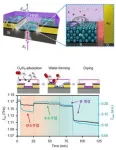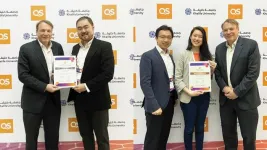(Press-News.org) Read all news releases on UAB’s peer-reviewed, published xenotransplant research and find media kits with video, photos, graphics and more at go.uab.edu/xenotransplant
The UAB News Studio is available for live or taped interviews with UAB experts.
BIRMINGHAM, Ala. – Currently used Food and Drug Administration-approved transplant drugs — with the addition of an also already FDA-approved complement inhibitor — are the optimal immunosuppression regimen for pig-to-human kidney transplants, according to a landmark discovery by University of Alabama at Birmingham investigators. The peer-reviewed research is published today in the Journal of Clinical Investigation.
“These findings establish the ideal immunosuppression regimen for pig-to-human kidney xenotransplantation, and it is a regimen that is already FDA-approved and that we routinely use for human-to-human allotransplantation,” said Jayme Locke, professor of surgery in UAB’s Marnix E. Heersink School of Medicine and lead author of the paper. “Our research found combining common immune-suppressing drugs with a complement inhibitor effectively managed the initial human immune response against transplanted pig kidneys.
“It’s a major departure from what’s been tried before in most non-human primate experiments and living human heart transplants, but it’s with a treatment regimen transplant doctors work with every day.”
The paper marks the third major peer-reviewed, published xenotransplant finding for UAB surgeon scientists since 2022. In each case, the team used the Parsons model, a pioneering pre-clinical human research model in a recipient experiencing brain death. The findings also continue to advance the science and promise of xenotransplantation as a therapy to potentially cure end-stage kidney disease — just as human-to-human allotransplantation can — and addresses the worldwide kidney organ shortage crisis. Currently, more than 800,000 people in the United States are living with kidney failure and 90,000 people are awaiting a kidney transplant.
Previously, in 2022, UAB’s research team announced the first peer-reviewed, published research in the American Journal of Transplantation which established that genetically modified pig kidneys were successfully transplanted into a recipient after brain death. That groundbreaking paper also recognized the Parsons model — developed at UAB in partnership with Legacy of Hope — could evaluate the safety and feasibility of pig-to-human kidney transplants without risk to a living human. It is named for transplant pioneer Jim Parsons, an organ donor whose family generously donated his body to advance xenotransplant kidney research.
And just last summer, in a paper published in JAMA Surgery, UAB’s research team established for the first time that pig kidneys could provide life-sustaining kidney function in humans.
JCI paper details
The peer-reviewed findings in today’s JCI online publication examine the case series of the three decedent model xenotransplants Locke’s UAB team has conducted.
Researchers used standard immunosuppression in the first decedent model, but they did not use a complement inhibitor. While the biopsies of the pig kidneys were histologically normal in the first model after being transplanted on the first day, they began to show some signs of rejection the day after transplant.
With the second and third decedent model studies, UAB researchers used standard immunosuppression and added a complement inhibitor, which is already a common, FDA-approved regimen for patients with a rare kidney disease known as atypical hemolytic uremic syndrome or AHUS. The complement inhibitor prevented the immune system from forming a membrane attack complex — a microscopic battering ram that breaks through a cell’s defenses, ultimately causing organ failure. Instead, when the complement inhibitor was used, the transplanted pig kidneys did not reject and were able to provide life-sustaining function.
“The membrane attack complex essentially sets up like a little drill on the surface of a cell and it drills holes in the cell,” Locke said. “If you drill holes in the cell, it weakens and it dies. If you kill enough cells, then the tissue dies. If you kill enough tissue, then the organ dies. The complement inhibitor prevents the formation of this drill on the surface of the cell. It’s like creating a force shield around the kidney.
“This finding is great news. We now know that we have an FDA-approved immunosuppression regimen already available. It’s a regimen that we know the patient can tolerate, and it is a treatment transplant doctors are familiar with and already know how to use. This is another critical piece that I hope will soon lead to FDA clearance for a Phase I clinical trial in living humans.”
Study support
These studies are supported by biotechnology pioneer United Therapeutics Corporation, which awarded a grant to UAB to launch the innovative xenotransplantation program. Revivicor, Inc., a subsidiary of United Therapeutics, provided the genetically modified pigs that were the source of the investigational xenotransplant kidneys called UKidney™. The 10-gene edited pigs are raised in a secure, pathogen-free facility by UAB animal care experts and are regularly tested for porcine cytomegalovirus (pCMV) and porcine endogenous retroviruses (PERV), including PERV-C. The pigs used in these studies tested negative for PERV-C and pCMV.
“Our partners at Revivicor and United Therapeutics have been incredibly supportive of Dr. Locke and our entire UAB research team, and we are grateful for the progress we have made together,” said UAB Heersink School of Medicine Dean and Senior Vice President of Medicine Anupam Agarwal, M.D. “We hope these efforts continue to move us forward toward FDA clearance for a Phase I clinical trial in living humans and hopefully add a new, desperately needed solution to address an organ shortage crisis responsible for tens of thousands of preventable deaths each year.”
This xenotransplantation study was led by the Division of Transplantation in the Department of Surgery, in close partnership with Legacy of Hope. Other key contributors to this work have included members of the Division of Infectious Diseases and the Division of Nephrology in the Department of Medicine; the Department of Anesthesiology and Perioperative Medicine; and the Department of Pathology. In addition to these specific contributors, the xenotransplantation program at UAB encompasses multiple departments and divisions of the Heersink School of Medicine and is also supported by numerous administrative and regulatory departments.
In addition to Locke, other UAB and Legacy of Hope authors on the JCI paper include Maggie Jones-Carr, M.D.; Huma Fatima, M.D.; Vineeta Kumar, M.D.; Douglas Anderson, M.D.; Julie Houp; Jackson Perry; Gavin Baker; Leigh McManus; Andrew Shunk; and Paige Porrett, M.D.
Disclosures: Locke reports consulting fees from Sanofi. Drs. Locke, Fatima, Anderson and Porrett report grant support from United Therapeutics and subsidiaries (Revivicor and Lung Biotechnology). United Therapeutics and its subsidiaries provided grant support for this research. The funder had no role in study design or conduct; data collection, management, analysis or interpretation; manuscript preparation or review; or in the decision to publish the manuscript.
About UAB transplant and the xenotransplant team
UAB Medicine is a world leader in organ transplantation and performed 9,592 kidney transplants from Jan. 1, 1988, to Dec. 31, 2023 — the second-most kidney transplants in the United States during that time, according to the Organ Procurement and Transplantation Network. UAB has also performed more kidney transplants in African Americans than any other transplant center, with 4,462 performed in the same period. The focus of UAB’s xenotransplantation program is to address the organ shortage by safely transplanting genetically modified pig kidneys into humans with kidney failure. Learn more. The focus of UAB’s xenotransplantation program is to address the organ shortage by safely transplanting genetically modified pig kidneys into humans with kidney failure. Learn more.
About UAB
Known for its innovative and interdisciplinary approach to education at both the graduate and undergraduate levels, the University of Alabama at Birmingham, a part of the University of Alabama System, is an internationally renowned research university and academic medical center with more than $715 million in annual research funding and an economic impact on the state exceeding $12.1 billion a year. UAB is Alabama’s largest employer, with some 28,000 employees, and was named Forbes’ No. 1 Large Employer in the United States in 2021. UAB enrollment surpassed 21,500 for the fifth consecutive year in fall 2022. The university offers more than 180 degree programs in nine schools and one college. The pillars of UAB’s mission include education, research, innovation and economic development, community engagement and patient care. Learn more at www.uab.edu.
About UAB Medicine
UAB Medicine comprises the Marnix E. Heersink School of Medicine and the $4.3 billion UAB Health System that includes all of the University of Alabama at Birmingham’s patient-care activities and 2,300 licensed beds in six hospitals, one of which is UAB Hospital — the third-largest public hospital in the United States, winner of the Women’s Choice award, and one of U.S. News & World Report’s Best Hospitals. UAB, a part of the University of Alabama System, is the state of Alabama’s largest single employer and an internationally renowned research university and academic health center; its professional schools and specialty patient-care programs are consistently ranked among the nation’s top 50. UAB is the largest academic medical center in Alabama and one of the top four largest academic medical centers in the United States. UAB is advancing innovative discoveries for better health as a three-time recipient of the prestigious Center for Translational Science Award. Find more information at www.uab.edu and www.uabmedicine.org.
END
Study: UAB researchers establish optimal immunosuppression regimen for pig-to-human kidney transplants
The regimen — which relies solely on already FDA-approved medications — showed remarkable success in Parsons model case series.
2024-01-25
ELSE PRESS RELEASES FROM THIS DATE:
Potassium-enriched salt is the missing ingredient in hypertension guidelines
2024-01-25
A call to include recommendations on low-sodium potassium-enriched salt in hypertension treatment guidelines has been made by an international group of experts today in the American Heart Association’s scientific journal Hypertension.
High levels of sodium intake and low levels of potassium intake are widespread, and both are linked to high blood pressure (hypertension) and greater risk of stroke, heart disease and premature death. Using a salt substitute where part of the sodium chloride is replaced with potassium chloride ...
Researchers establish brain pathway linking motivation, addiction and disease
2024-01-25
New findings published in the journal Nature Neuroscience have shed light on a mysterious pathway between the reward center of the brain that is key to how we form habits, known as the basal ganglia, and another anatomically distinct region where nearly three-quarters of the brain’s neurons reside and assist in motor learning, known as the cerebellum.
Researchers say the connection between the two regions potentially changes our fundamental view of how the brain processes voluntary ...
How COVID changed the way Americans work, and how much money they have
2024-01-25
According to a new paper in the Review of Economic Studies, published by Oxford University Press, the widespread adoption of work-from-home technology has had dramatic consequences for American life. Using an equilibrium model where people choose where to live and how to allocate their time between working at home and at the office, the researchers here find that the pandemic induced a substantial increase in the relative productivity of those working from home. This change has increased housing prices, reduced office rent costs, and will permanently ...
Development of real-time trace hydrogen gas leakage via a novel terahertz-wave optical platform
2024-01-25
Hydrogen gas is the smallest and lightest of all known molecules, and its colorless and odorless nature makes it easy to leak. Also when concentrated above 4% in a confined space, it poses a risk of ignition or explosion. In order for hydrogen to become a major player in the future energy industry, it is essential to ensure the safety issues via ultra-sensitive gas detection technology over the entire gas-dealing processes such as gas production, storage, and transportation. However, conventional gas-leakage sensors using electric signals are prone to yield electrical sparks, which can cause an explosion of leaked hydrogen gas. In addition, the mainstream electrode-based contact sensors ...
Advanced Full-color image sensor technology enabling simultaneous energy harvesting and imaging
2024-01-25
Organic-based optoelectronic technology is increasingly recognized as an energy-efficient solution for low-power indoor electronics and wireless IoT sensors. This is largely due to its superior flexibility and light weight compared to conventional silicon-based devices. Notably, organic photovoltaic cells (OPVs) and organic photodetectors (OPDs) are leading examples in this field. OPVs have the remarkable ability to absorb energy and generate electricity even under very low light condition, while OPDs are capable of capturing images. However, despite their potential, the development ...
New analysis shows that disinfection is the most effective way to prevent viral contamination of restroom surfaces
2024-01-25
Arlington, Va. — January 25, 2024 — A new study published today in the American Journal of Infection Control (AJIC) demonstrates that viral particles spread to many restroom surfaces during toilet flushing, regardless of whether the toilet lid is up or down. In this analysis, the only meaningful way of reducing viral particles was through disinfection of the toilet, toilet water, and nearby surfaces.
Scientists have long known that the process of toilet flushing can aerosolize pathogens expelled into the toilet bowl by an unhealthy individual. The aerosol plume created from the force of flushing can ...
Diverse forests are best at standing up to storms
2024-01-25
European forests with a greater diversity of tree species are more resilient to storms, according to new research published in the British Ecological Society journal, Functional Ecology.
A new study by researchers at the French National Research Institute for Agriculture, Food and Environment (INRAE) reveals that in Europe, the forests that are most resilient to storms are those with a greater diversity of tree species and dominated by slow growing species with high wood density, like oaks.
The researchers also found that the positive effect of ...
More reporting needed to show progress on Ontario municipal climate and sustainability plans
2024-01-25
While sustainability reporting is a widespread practice in the private sector, new research shows that the same cannot be said for Ontario municipalities.
Researchers at the University of Waterloo studied 38 municipalities in Ontario, representing more than two-thirds of the population, and discovered that almost all municipalities publish their sustainability and climate change goals, but under half are formally reporting on their progress.
Municipalities are a key part of the equation ...
Recovering lossless propagation: HKU physicists overcoming optical loss in polariton system with synthetic complex frequency waves
2024-01-25
A collaborative research team co-led by Professor Shuang ZHANG, the Interim Head of the Department of Physics, The University of Hong Kong (HKU), along with Professor Qing DAI from National Center for Nanoscience and Technology, China, has introduced a solution to a prevalent issue in the realm of nanophotonics – the study of light at an extremely small scale. Their findings, recently published in the prestigious academic journal Nature Materials, propose a synthetic complex frequency wave (CFW) approach to address optical loss in polariton propagation. These findings offer practical solutions such as more efficient light-based devices for faster and ...
HKU Common Core and HKUMed teams win one Silver and one Bronze in QS Reimagine Education Awards
2024-01-25
Two innovative teaching and learning projects led by The University of Hong Kong (HKU) earned honours in the Quacquarelli Symonds (QS) Reimagine Education Awards, presented in Abu Dhabi in December 2023.
Often referred to as the "Oscars of Education," the awards are designed to honour the most innovative and effective approaches to enhancing student learning experiences and employability outcomes.
The 2023 QS Reimagine Education Awards received a record number of more than 1,200 submissions across 17 categories. HKU has garnered ...
LAST 30 PRESS RELEASES:
Making lighter work of calculating fluid and heat flow
Normalizing blood sugar can halve heart attack risk
Lowering blood sugar cuts heart attack risk in people with prediabetes
Study links genetic variants to risk of blinding eye disease in premature infants
Non-opioid ‘pain sponge’ therapy halts cartilage degeneration and relieves chronic pain
AI can pick up cultural values by mimicking how kids learn
China’s ecological redlines offer fast track to 30 x 30 global conservation goal
Invisible indoor threats: emerging household contaminants and their growing risks to human health
Adding antibody treatment to chemo boosts outcomes for children with rare cancer
Germline pathogenic variants among women without a history of breast cancer
Tanning beds triple melanoma risk, potentially causing broad DNA damage
Unique bond identified as key to viral infection speed
Indoor tanning makes youthful skin much older on a genetic level
Mouse model sheds new light on the causes and potential solutions to human GI problems linked to muscular dystrophy
The Journal of Nuclear Medicine ahead-of-print tip sheet: December 12, 2025
Smarter tools for peering into the microscopic world
Applications open for funding to conduct research in the Kinsey Institute archives
Global measure underestimates the severity of food insecurity
Child survivors of critical illness are missing out on timely follow up care
Risk-based vs annual breast cancer screening / the WISDOM randomized clinical trial
University of Toronto launches Electric Vehicle Innovation Ontario to accelerate advanced EV technologies and build Canada’s innovation advantage
Early relapse predicts poor outcomes in aggressive blood cancer
American College of Lifestyle Medicine applauds two CMS models aligned with lifestyle medicine practice and reimbursement
Clinical trial finds cannabis use not a barrier to quitting nicotine vaping
Supplemental nutrition assistance program policies and food insecurity
Switching immune cells to “night mode” could limit damage after a heart attack, study suggests
URI-based Global RIghts Project report spotlights continued troubling trends in worldwide inhumane treatment
Neutrophils are less aggressive at night, explaining why nighttime heart attacks cause less damage than daytime events
Menopausal hormone therapy may not pose breast cancer risk for women with BRCA mutations
Mobile health tool may improve quality of life for adolescent and young adult breast cancer survivors
[Press-News.org] Study: UAB researchers establish optimal immunosuppression regimen for pig-to-human kidney transplantsThe regimen — which relies solely on already FDA-approved medications — showed remarkable success in Parsons model case series.




